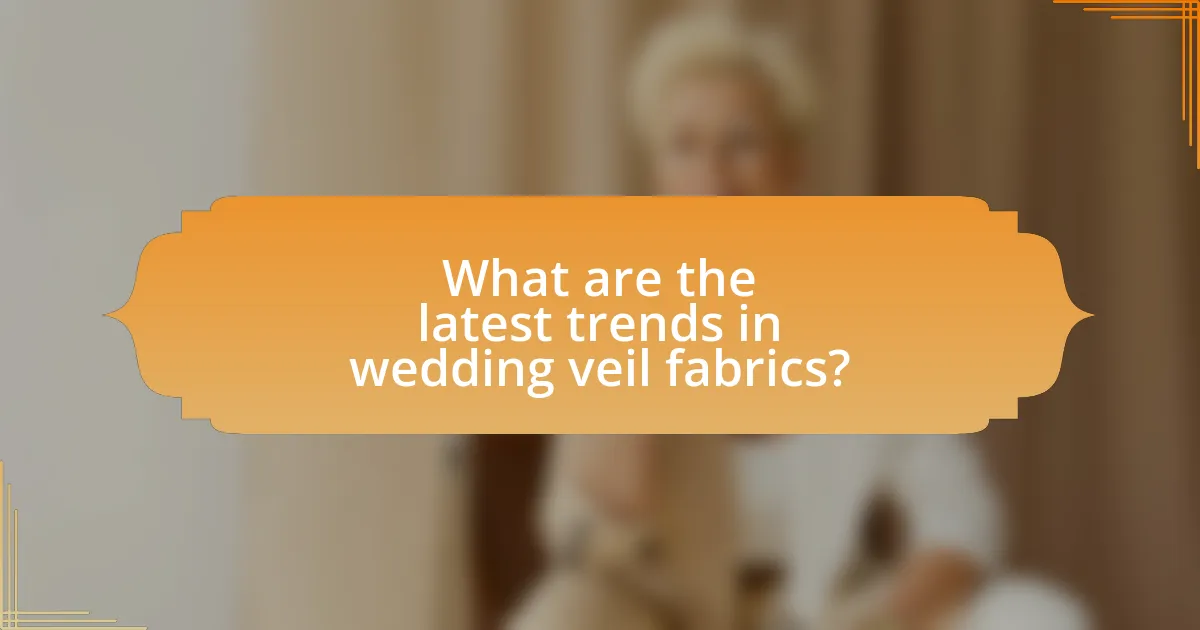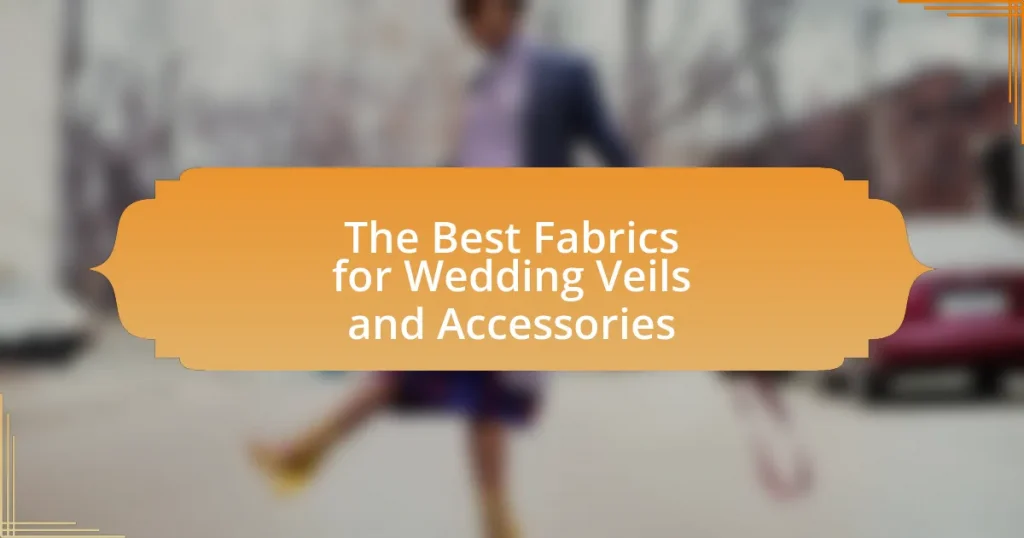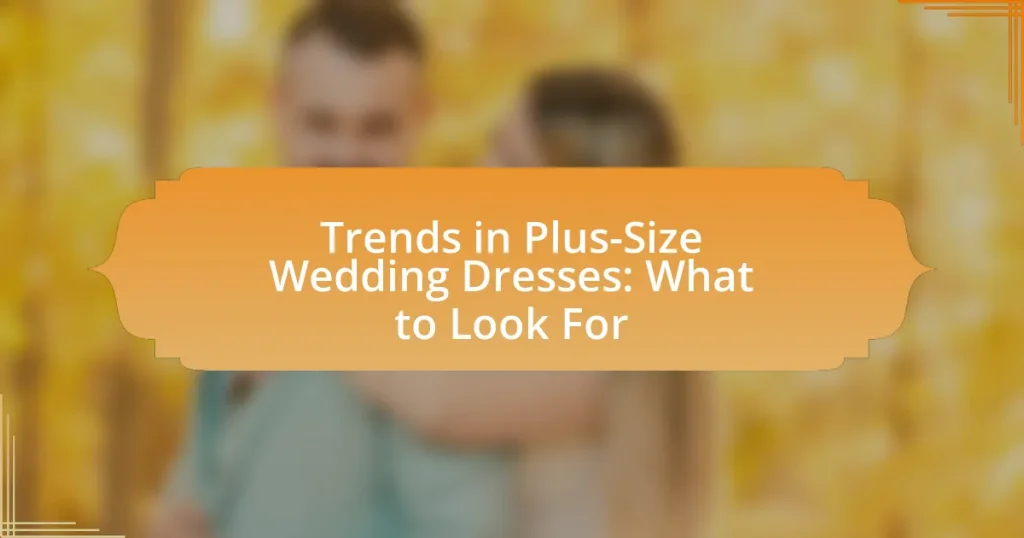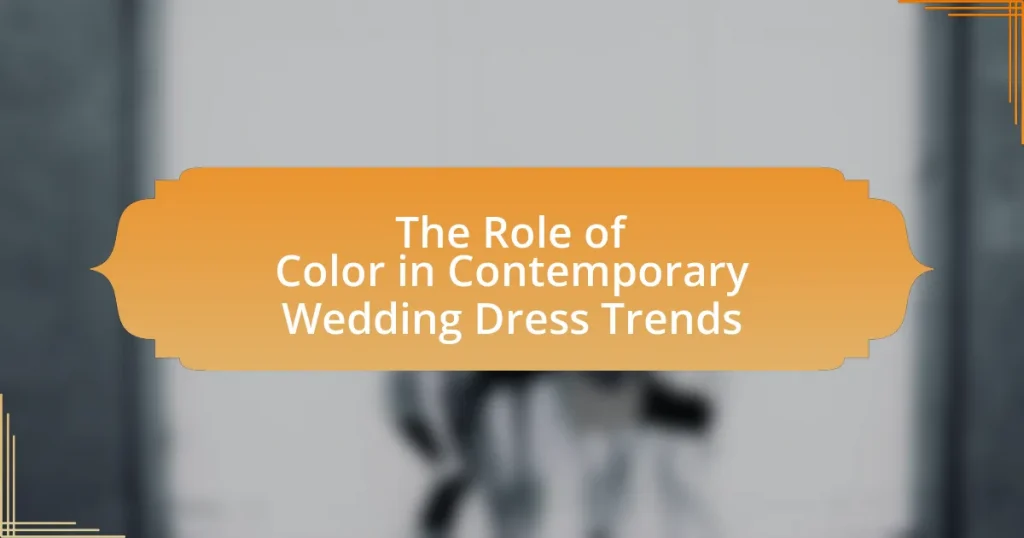The article focuses on the best fabrics for wedding veils and accessories, highlighting options such as tulle, lace, chiffon, and organza. It discusses how different fabrics impact the overall look, drape, and flow of veils, emphasizing the importance of transparency, weight, and texture in fabric selection. Additionally, the article covers the significance of fabric choice in relation to comfort, durability, and how it complements the wedding dress. It also explores current trends in veil fabrics and offers best practices for maintaining and caring for delicate materials.

What are the Best Fabrics for Wedding Veils and Accessories?
The best fabrics for wedding veils and accessories include tulle, lace, chiffon, and organza. Tulle is a lightweight, net-like fabric that provides a delicate and ethereal look, making it a popular choice for veils. Lace adds intricate detailing and texture, often used in both veils and accessories to enhance elegance. Chiffon is a soft, flowing fabric that drapes beautifully, ideal for creating romantic and airy designs. Organza, known for its crispness and sheen, offers structure and volume, making it suitable for statement pieces. These fabrics are favored for their aesthetic qualities and versatility in bridal fashion.
How do different fabrics impact the overall look of wedding veils?
Different fabrics significantly impact the overall look of wedding veils by influencing their texture, drape, and visual appeal. For instance, silk creates a luxurious and smooth appearance, enhancing elegance, while tulle offers a light, airy feel that adds volume and softness. Lace, on the other hand, introduces intricate patterns and a romantic touch, making the veil more visually striking. Additionally, organza provides a crisp structure, allowing for dramatic shapes and layers. Each fabric’s unique characteristics contribute to the veil’s overall aesthetic, ensuring it complements the bride’s gown and theme of the wedding.
What characteristics should be considered when choosing fabric for veils?
When choosing fabric for veils, key characteristics to consider include transparency, weight, drape, and texture. Transparency affects how light passes through the veil, influencing the overall look; lighter fabrics like tulle offer more transparency, while heavier fabrics like satin provide a more opaque appearance. Weight impacts the veil’s flow and movement; lightweight fabrics create a soft, ethereal effect, while heavier materials can add structure. Drape determines how the fabric falls and frames the face; fabrics with good drape, such as chiffon, enhance elegance. Lastly, texture contributes to the visual interest and feel of the veil; smooth fabrics like silk contrast with textured options like lace, allowing for personalization. These characteristics collectively influence the aesthetic and functional aspects of the veil.
How does the choice of fabric affect the veil’s drape and flow?
The choice of fabric significantly influences a veil’s drape and flow. Fabrics like tulle and chiffon are lightweight and airy, allowing for a soft, flowing appearance that enhances movement. In contrast, heavier fabrics such as satin or silk create a more structured look, resulting in a stiffer drape that may not flow as freely. The inherent properties of each fabric, such as weight, texture, and stiffness, directly affect how the veil interacts with air and body movement, ultimately determining its visual and physical characteristics. For example, tulle’s sheer quality allows it to flutter gently, while satin’s smooth surface can create a more elegant, polished silhouette.
What types of fabrics are commonly used for wedding veils?
Commonly used fabrics for wedding veils include tulle, lace, organza, and chiffon. Tulle is a lightweight, net-like fabric that provides a classic and ethereal look, often used for its volume and structure. Lace, known for its intricate patterns, adds a romantic and vintage touch to veils. Organza is a crisp, sheer fabric that offers a more structured appearance, while chiffon is soft and flowy, creating a delicate and graceful effect. These fabrics are favored for their aesthetic qualities and ability to complement various wedding styles.
What are the benefits of using tulle for wedding veils?
Tulle offers several benefits for wedding veils, including its lightweight nature, versatility, and elegant appearance. The lightweight quality of tulle allows for comfortable wear throughout the wedding day, making it an ideal choice for brides. Its versatility enables it to be easily layered or styled in various ways, accommodating different bridal aesthetics. Additionally, tulle’s sheer texture creates a soft, romantic look that enhances the overall bridal ensemble. These characteristics make tulle a popular fabric choice for wedding veils among brides seeking both functionality and beauty.
How does lace enhance the beauty of wedding accessories?
Lace enhances the beauty of wedding accessories by adding intricate patterns and textures that evoke elegance and romance. The delicate nature of lace creates a visually appealing contrast against other materials, making accessories like veils, garters, and headpieces stand out. Historically, lace has been associated with luxury and sophistication, often used in bridal fashion since the 16th century, which reinforces its status as a timeless choice for weddings. The versatility of lace allows it to complement various styles, from vintage to modern, further enhancing the overall aesthetic of wedding attire.
What role does chiffon play in creating elegant veils?
Chiffon plays a crucial role in creating elegant veils due to its lightweight and sheer qualities. This fabric allows for a delicate drape that enhances the ethereal appearance of veils, making them appear soft and romantic. Additionally, chiffon can be easily layered, which adds depth and dimension to the veil while maintaining a graceful flow. Its versatility in colors and patterns further allows for customization, enabling brides to achieve a personalized and sophisticated look. The combination of these characteristics makes chiffon a preferred choice for elegant wedding veils.
Why is fabric choice important for wedding accessories?
Fabric choice is important for wedding accessories because it directly affects the overall aesthetic, comfort, and durability of the items. The right fabric enhances the visual appeal, ensuring that accessories complement the wedding theme and attire. For example, silk offers a luxurious look and feel, while lace adds a romantic touch. Additionally, the choice of fabric impacts comfort; lightweight materials like chiffon are breathable, making them suitable for long wear. Durability is also crucial, as high-quality fabrics withstand the rigors of the event, maintaining their appearance throughout the day. Thus, selecting the appropriate fabric is essential for achieving the desired look and functionality in wedding accessories.
How does fabric affect the comfort of bridal accessories?
Fabric significantly affects the comfort of bridal accessories by influencing breathability, weight, and texture. Lightweight fabrics like chiffon and tulle provide a soft, airy feel, reducing discomfort during long wear, while heavier materials like satin can cause overheating and restrict movement. Additionally, the texture of the fabric impacts how it feels against the skin; smooth fabrics minimize irritation, whereas rougher textures may lead to chafing. Studies indicate that natural fibers, such as cotton and silk, enhance comfort due to their moisture-wicking properties, which help regulate temperature and keep the wearer dry.
What are the implications of fabric durability for wedding day wear?
Fabric durability significantly impacts wedding day wear by ensuring that garments withstand the rigors of the event, including movement, weather, and potential spills. Durable fabrics, such as silk or polyester blends, maintain their appearance and structural integrity throughout the day, reducing the likelihood of tears or damage. For instance, a study by the Fashion Institute of Technology highlights that fabrics with higher tensile strength can endure more stress, making them ideal for long events like weddings where wear and tear are common. This durability not only enhances the longevity of the attire but also contributes to the overall comfort and confidence of the wearer, allowing them to enjoy their special day without concern for wardrobe malfunctions.

How do I choose the right fabric for my wedding veil?
To choose the right fabric for your wedding veil, consider the veil’s style, the overall wedding theme, and the season. Fabrics like tulle are lightweight and airy, making them ideal for a romantic look, while lace adds elegance and texture, suitable for vintage themes. Additionally, silk offers a luxurious feel and drapes beautifully, perfect for formal weddings. The choice of fabric should also reflect comfort and how it complements your wedding dress, ensuring a cohesive appearance.
What factors should I consider when selecting veil fabric?
When selecting veil fabric, consider the fabric type, weight, drape, and opacity. Different fabrics such as tulle, lace, and organza offer varying levels of structure and softness, impacting the overall look of the veil. The weight of the fabric affects how it falls; lighter fabrics create a more ethereal appearance, while heavier fabrics provide more volume. Drape is crucial for how the veil frames the face and flows behind, with softer fabrics offering a more romantic look. Opacity influences visibility; sheer fabrics allow for a delicate, airy feel, while denser fabrics provide more coverage. Each of these factors plays a significant role in achieving the desired aesthetic for the wedding veil.
How do my wedding theme and style influence fabric choice?
Your wedding theme and style significantly influence fabric choice by dictating the aesthetic and emotional tone of the event. For instance, a rustic wedding theme may favor natural fabrics like linen or cotton, which evoke a casual and organic feel, while a formal theme might lean towards luxurious fabrics such as silk or satin to convey elegance and sophistication. The choice of fabric directly correlates with the overall design elements, as specific textures and finishes can enhance or detract from the intended atmosphere of the wedding.
What is the significance of color and texture in fabric selection?
Color and texture are crucial in fabric selection as they significantly influence the aesthetic appeal and emotional impact of wedding veils and accessories. The choice of color can evoke specific feelings and set the overall tone of the wedding, with options like white symbolizing purity and vibrant hues reflecting personal style. Texture, on the other hand, affects the visual interest and tactile experience of the fabric; for instance, lace adds elegance and delicacy, while satin offers a smooth, luxurious feel. Studies in color psychology indicate that colors can affect mood and perception, reinforcing the importance of thoughtful selection in creating a desired atmosphere for the event.
How can I ensure the fabric complements my wedding dress?
To ensure the fabric complements your wedding dress, select materials that match or enhance the dress’s texture, color, and style. For instance, if your dress is made of lace, consider a veil or accessories that also feature lace to create a cohesive look. Additionally, pay attention to the color; fabrics in similar shades or with complementary tones will harmonize better. Research indicates that matching fabric types, such as silk with silk or tulle with tulle, can create a seamless appearance, enhancing the overall aesthetic of your bridal ensemble.
What are the best practices for matching veil fabric with dress materials?
The best practices for matching veil fabric with dress materials include considering the texture, color, and weight of both fabrics. Texturally, a veil made of lace pairs well with a dress featuring similar lace details, while a smooth satin veil complements a structured gown. Color-wise, the veil should either match the dress exactly or be a shade lighter or darker to create a harmonious look. Additionally, the weight of the veil should align with the dress; for instance, a lightweight tulle veil works best with a flowy chiffon dress, ensuring balance and cohesion in the overall appearance. These practices ensure that the veil enhances the dress rather than overpowering it.
How do embellishments on the dress affect veil fabric choice?
Embellishments on a dress significantly influence the choice of veil fabric by determining the level of contrast and harmony between the two elements. For instance, intricate embellishments such as lace, beading, or embroidery may require a veil made from lightweight, sheer fabrics like tulle or organza to avoid overwhelming the overall look. Conversely, if the dress features minimal embellishments, a more structured veil fabric, such as satin or silk, can complement the simplicity while adding elegance. This relationship is crucial because the veil should enhance the dress’s details rather than compete with them, ensuring a cohesive bridal aesthetic.

What are the latest trends in wedding veil fabrics?
The latest trends in wedding veil fabrics include lightweight tulle, lace, and organza, which are favored for their ethereal quality and versatility. Lightweight tulle is popular for its airy feel, allowing for a romantic look without overwhelming the bridal gown. Lace remains a timeless choice, often used for its intricate detailing and ability to complement various dress styles. Organza is gaining traction for its crisp texture and ability to hold shape, making it ideal for structured veils. These fabric choices reflect a shift towards a more modern, minimalist aesthetic while still honoring traditional elements in bridal fashion.
How are modern fabrics changing the traditional veil landscape?
Modern fabrics are transforming the traditional veil landscape by introducing innovative materials that enhance both aesthetics and functionality. For instance, lightweight tulle and lace are being replaced or complemented by synthetic blends that offer greater durability and ease of care, allowing for intricate designs without compromising on comfort. Additionally, fabrics like chiffon and organza provide a softer drape and a more ethereal look, appealing to contemporary bridal trends. The use of technologically advanced materials, such as water-resistant fabrics and those with built-in UV protection, further reflects a shift towards practicality in modern veil design, catering to diverse wedding environments and climates.
What innovative materials are being used in contemporary wedding veils?
Contemporary wedding veils are increasingly made from innovative materials such as tulle, lace, and organza, often enhanced with technology for added features. For instance, some veils incorporate lightweight, breathable fabrics that allow for better airflow and comfort, while others utilize sustainable materials like recycled polyester or organic cotton to appeal to eco-conscious brides. Additionally, advancements in fabric technology have led to the creation of veils with built-in LED lights or smart textiles that can change color or pattern, providing a unique and customizable experience. These materials not only enhance the aesthetic appeal of the veils but also offer functionality and sustainability, reflecting current trends in the bridal fashion industry.
How do fashion trends influence fabric choices for wedding accessories?
Fashion trends significantly influence fabric choices for wedding accessories by dictating the styles, textures, and colors that are in vogue. For instance, the rise of minimalist aesthetics has led to a preference for lightweight fabrics like chiffon and silk, which offer a clean and elegant look. Conversely, trends favoring vintage or bohemian styles have increased the popularity of lace and embroidered fabrics, which add intricate details and a sense of nostalgia. Additionally, seasonal trends can affect color palettes, with pastel shades often dominating spring weddings, while richer hues may be favored in fall. This alignment with current fashion trends ensures that wedding accessories not only complement the bridal gown but also resonate with contemporary style preferences, making them more appealing to modern brides.
What are some tips for maintaining and caring for veil fabrics?
To maintain and care for veil fabrics, it is essential to handle them gently and store them properly. First, always store veil fabrics in a cool, dry place, ideally in a breathable garment bag to prevent dust accumulation and damage. Second, avoid exposing veil fabrics to direct sunlight for extended periods, as UV rays can cause fading and deterioration. Third, when cleaning, opt for dry cleaning or hand washing in cold water with a mild detergent, as machine washing can lead to fraying or tearing. Additionally, avoid using bleach or harsh chemicals, which can weaken the fibers. Finally, when ironing, use a low heat setting and place a cloth between the iron and the fabric to prevent scorching. These practices help preserve the integrity and appearance of veil fabrics over time.
How can I properly clean and store my wedding veil after the event?
To properly clean and store your wedding veil after the event, first, gently hand wash it in cold water using a mild detergent specifically designed for delicate fabrics. This method prevents damage to the veil’s material, which is often made of lace, tulle, or silk. After washing, rinse thoroughly and lay the veil flat on a clean, dry towel to absorb excess water, avoiding wringing or twisting.
For storage, place the dry veil in a breathable fabric bag or a box lined with acid-free tissue paper to protect it from dust and light. Avoid plastic bags, as they can trap moisture and lead to mildew. This cleaning and storage method preserves the integrity of the veil, ensuring it remains in excellent condition for future use or display.
What precautions should I take to avoid damaging delicate fabrics?
To avoid damaging delicate fabrics, handle them with care by using gentle washing methods and avoiding harsh chemicals. Delicate fabrics, such as silk and lace, require cold water and mild detergents to prevent deterioration. Additionally, always air dry these materials instead of using a dryer, as heat can cause shrinkage or distortion. Storing delicate fabrics in breathable garment bags protects them from dust and potential snags. These precautions are essential because delicate fabrics are more susceptible to wear and tear, and proper care extends their lifespan significantly.
What are the best practices for selecting and using fabrics for wedding veils and accessories?
The best practices for selecting and using fabrics for wedding veils and accessories include choosing lightweight materials like tulle, lace, or chiffon for a delicate appearance and ensuring the fabric complements the wedding dress. Tulle is popular for its airy quality, while lace adds texture and elegance. Additionally, consider the veil’s length and style, as these factors influence the fabric’s drape and overall look. For accessories, silk or satin can provide a luxurious finish. It is essential to test the fabric against skin tones and dress colors to ensure harmony. These practices are validated by industry standards, which emphasize the importance of fabric choice in achieving a cohesive bridal look.



